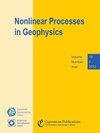Exploring the influence of spatio-temporal scale differences in Coupled Data Assimilation
IF 1.7
4区 地球科学
Q3 GEOSCIENCES, MULTIDISCIPLINARY
引用次数: 0
Abstract
Abstract. Identifying the optimal strategy for initializing coupled climate prediction systems is challenging due to the spatio-temporal scale separation and disparities in the observational network. We aim to clarify when strongly coupled data assimilation (SCDA) is preferable to weakly coupled data assimilation (WCDA). We use a two-components coupled Lorenz-63 system and the Ensemble Kalman Filter (EnKF) to compare WCDA and SCDA for diverse spatio-temporal scale separations and observational networks – only in the atmosphere, the ocean, or both components. When both components are observed, SCDA and WCDA yield similar performances. However, sometimes SCDA performs marginally worse due to its higher sensitivity (as opposed to WCDA) to key approximations in the EnKF – linear analysis update and sampling error. When observations are only in one of the components, SCDA systematically outperforms WCDA. The spatio-temporal scale separation determines SCDA's performance in this scenario and the largest improvements are found when the observed component has a smaller spatial scale. This suggests that SCDA of fast atmospheric observations can potentially improve the large-slow ocean component. Conversely, observations of the fine ocean can improve the large atmosphere at a comparable temporal scale. However, when both components are highly chaotic, and the observed component's spatial scale is the largest, SCDA does not improve over WCDA. In such a case, the cross-updates may become too sensitive to data assimilation approximations.探索耦合数据同化中时空尺度差异的影响
摘要由于观测网络的时空尺度分离和差异,确定耦合气候预测系统初始化的最佳策略具有挑战性。我们旨在阐明何时强耦合数据同化(SCDA)优于弱耦合数据同化(WCDA)。我们利用双分量耦合洛伦兹-63系统和集合卡尔曼滤波器(EnKF),比较了WCDA和SCDA在不同时空尺度分离和观测网络中的应用--仅在大气、海洋或两个分量中。当观测到两个分量时,SCDA 和 WCDA 的性能相似。然而,由于 SCDA 对 EnKF 的关键近似值--线性分析更新和采样误差--具有更高的敏感性(相对于 WCDA),因此 SCDA 的性能有时会略逊一筹。当观测结果只存在于其中一个分量中时,SCDA 的表现会明显优于 WCDA。在这种情况下,时空尺度的分离决定了 SCDA 的性能,当观测成分的空间尺度较小时,SCDA 的性能提高最大。这表明,快速大气观测数据的 SCDA 有可能改善大慢速海洋分量。反之,对精细海洋的观测也能在类似的时间尺度上改善大型大气。然而,当两个分量都高度混沌,且观测分量的空间尺度最大时,SCDA 不会比 WCDA 更好。在这种情况下,交叉更新可能对数据同化近似过于敏感。
本文章由计算机程序翻译,如有差异,请以英文原文为准。
求助全文
约1分钟内获得全文
求助全文
来源期刊

Nonlinear Processes in Geophysics
地学-地球化学与地球物理
CiteScore
4.00
自引率
0.00%
发文量
21
审稿时长
6-12 weeks
期刊介绍:
Nonlinear Processes in Geophysics (NPG) is an international, inter-/trans-disciplinary, non-profit journal devoted to breaking the deadlocks often faced by standard approaches in Earth and space sciences. It therefore solicits disruptive and innovative concepts and methodologies, as well as original applications of these to address the ubiquitous complexity in geoscience systems, and in interacting social and biological systems. Such systems are nonlinear, with responses strongly non-proportional to perturbations, and show an associated extreme variability across scales.
 求助内容:
求助内容: 应助结果提醒方式:
应助结果提醒方式:


